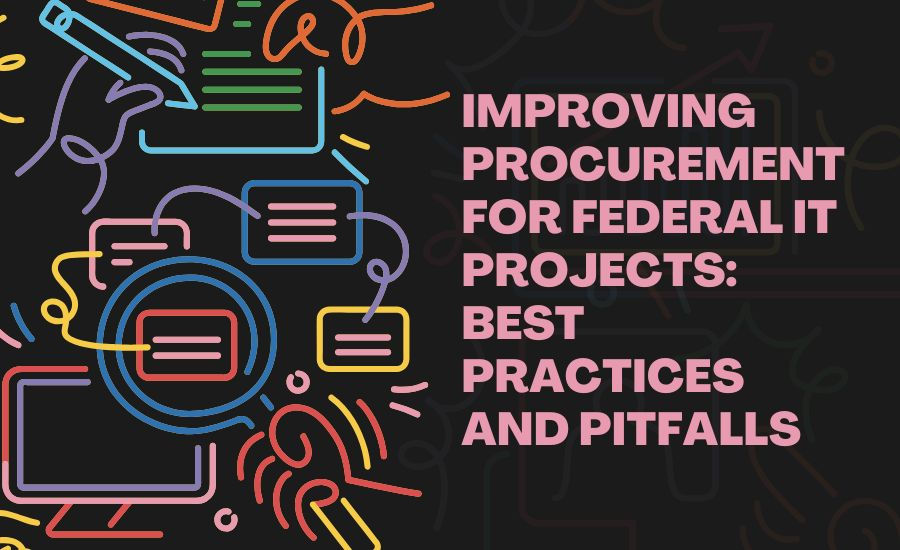Improving Procurement for Federal IT Projects: Best Practices and Pitfalls
- Harshil Shah
- Oct 13
- 3 min read

Federal Chief Information Officers (CIOs) face a difficult balancing act when it comes to IT procurement. They must deliver modern, secure, and cost-effective technology solutions while navigating complex acquisition regulations and limited budgets. Too often, innovation stalls not because of technical barriers—but because of procurement inefficiencies. Building smarter, faster, and more accountable procurement processes is essential for digital transformation across government.
The Challenge of Federal IT Procurement
Traditional procurement processes were not designed for the rapid pace of modern technology. Lengthy contracting timelines, rigid requirements, and fragmented oversight can delay projects and drive up costs. CIOs must reimagine procurement as a strategic enabler of modernization—not an administrative hurdle. That means fostering closer collaboration between acquisition, finance, and IT leadership from the start.
Best Practices for Smarter IT Procurement
1. Start with Clear Mission Outcomes
Every IT investment should directly tie to agency mission goals. Before issuing a request for proposal (RFP), CIOs should define measurable mission outcomes, not just technical specifications. This outcome-based approach allows vendors to innovate while ensuring the final solution advances the agency’s strategic priorities.
2. Use Modular and Agile Contracting
Large, multi-year contracts increase risk and reduce flexibility. CIOs should promote modular procurement—breaking large projects into smaller, iterative phases. Agile contracting enables agencies to test, learn, and adjust along the way. It also helps vendors deliver incremental value faster while reducing long-term failure rates.
3. Evaluate Vendors Beyond Price
Cost remains important, but value and capability should drive selection. CIOs should assess vendors based on technical competence, past performance, cybersecurity readiness, and ability to integrate with existing systems. Vendor evaluation frameworks that balance price with innovation, scalability, and risk management lead to better project outcomes.
4. Foster Early Collaboration Between IT and Procurement Teams
Successful procurement starts before the RFP is written. CIOs should ensure early collaboration between IT staff, procurement officers, and legal advisors. This alignment avoids miscommunication, accelerates approvals, and ensures technical requirements are realistic and compliant with acquisition rules.
5. Build Strong Vendor Relationships
Post-award engagement matters just as much as selection. CIOs should maintain open communication channels with contractors, conduct regular performance reviews, and use data-driven metrics to evaluate delivery. This transparency encourages accountability and helps identify issues before they escalate into project delays or budget overruns.
Common Pitfalls to Avoid
Overly Prescriptive Requirements: Stifles innovation and limits vendor flexibility.
Insufficient Market Research: Leads to unrealistic pricing and outdated technology choices.
One-Time Vendor Engagement: Fails to capture feedback or lessons learned for future projects.
Ignoring Security from the Start: Adds costly retrofits later in the project lifecycle.
Weak Performance Metrics: Makes it difficult to hold vendors accountable for results.
Data-Driven Procurement Decisions
Modern CIOs are embracing data analytics to improve acquisition decisions. By tracking project performance, vendor reliability, and cost trends, agencies can identify what works—and what doesn’t. Data-driven procurement enhances transparency, strengthens compliance, and ensures taxpayer dollars are invested wisely.
Looking Ahead
The next phase of federal IT modernization depends on procurement reform that keeps pace with innovation. By adopting modular contracting, focusing on mission outcomes, and fostering collaboration across departments, CIOs can transform procurement from a bottleneck into a competitive advantage. The future of digital government will be built not just on technology—but on smarter acquisition.
For more strategies and leadership insights for federal CIOs driving digital modernization, visitCIOMeet.org.




Comments